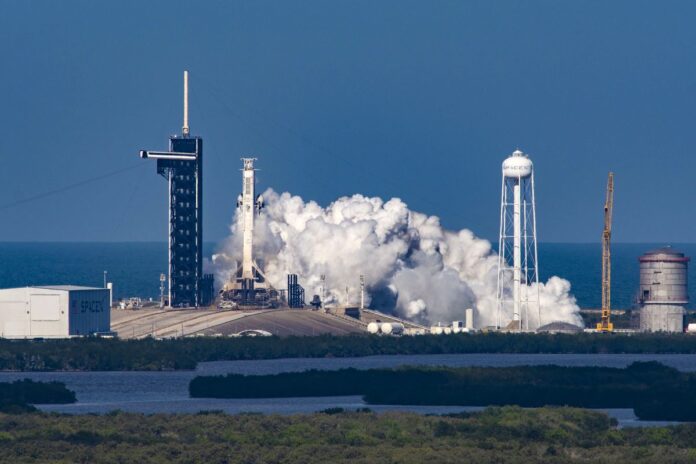SpaceX’s powerful Falcon Heavy rocket has flexed its muscles ahead of a planned liftoff this weekend.
SpaceX just performed a “static fire” test with the Falcon Heavy at Pad 39A at NASA’s Kennedy Space Center in Florida, lighting up the rocket’s 27 first-stage Merlin engines while the vehicle remained anchored to the ground.
Static fires are common prelaunch tests for SpaceX, and the Falcon Heavy is indeed gearing up for a liftoff in the near future.
“Full duration static fire of Falcon Heavy complete; targeting no earlier than Saturday, January 14 for launch of the USSF-67 mission from Florida,” SpaceX said via Twitter on Tuesday (opens in new tab) (Jan. 10), in a post that also featured a photo of the static fire.
Related: Why SpaceX hadn’t flown a Falcon Heavy rocket since 2019
As that mission name suggests, Falcon Heavy will fly USSF-67 for the U.S. Space Force. The nation’s newest military branch was also the customer for the most recent Falcon Heavy flight, called USSF- 44, which launched on Nov. 1, 2022.
USSF-44 sent a handful of classified payloads to geostationary orbit (GEO), about 22,200 miles (35,700 kilometers) above Earth. USSF-67 will also target GEO, launching a military communications satellite and a spacecraft capable of carrying six small satellites to that relatively distant destination, according to SpaceNews (opens in new tab).
USSF-44 was the first Falcon Heavy mission since June 2019. That long gap was due primarily to delays in the readiness of customer payloads, according to space industry analysts.
The Falcon Heavy consists of three strapped-together first stages of SpaceX’s workhorse Falcon 9 rocket. The central booster is topped with an upper stage, which carries the payloads.
Falcon 9 and Falcon Heavy first stages are designed to be reusable. The two side boosters on USSF-67 will be reused from USSF-44, according to SpaceNews, and will attempt to land again for future reuse. USSF-67’s central core is new and will not attempt a landing on Saturday, SpaceNews reported.
Saturday’s planned liftoff will continue a busy stretch for SpaceX. Elon Musk’s company launched 40 internet satellites for the London-based company OneWeb on Monday night (Jan. 9) and plans to loft 51 of its own Starlink broadband craft on Tuesday night.
In addition, SpaceX’s robotic Dragon cargo capsule left the International Space Station on Monday to head back down to Earth. Dragon is expected to splash down off the Florida coast on Wednesday (Jan. 11), bringing an end to SpaceX’s CRS-26 resupply mission for NASA.
Mike Wall is the author of “Out There (opens in new tab)” (Grand Central Publishing, 2018; illustrated by Karl Tate), a book about the search for alien life. Follow him on Twitter @michaeldwall (opens in new tab). Follow us on Twitter @Spacedotcom (opens in new tab) or Facebook (opens in new tab).

